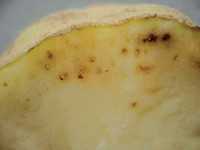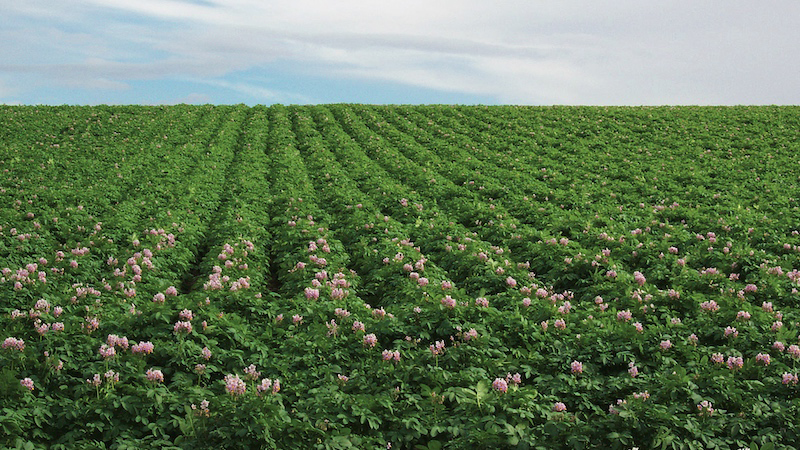Nasty Nematodes

Nematodes can create big problems for Florida potato growers, particularly the root-knot, sting, and stubby-root. These nematodes can lead to serious quality defects in the tubers and severely reduce yields, so growers should rely on a strong integrated pest management program to address the unseen, tiny pest.
Foliar symptoms of nematode infestation of roots generally involve stunting and general unthriftiness of the plant, premature wilting and slow recovery to improved soil moisture conditions, leaf chlorosis (yellowing), and other symptoms characteristic of nutrient deficiency. Under heavy nematode infestation, crop seedlings or transplants may fail to develop, maintaining a stunted condition, or die, causing poor or patchy stand development. Under less severe infestation levels, symptom expression may be delayed until later in the crop season after a number of nematode reproductive cycles have been completed on the crop.
Simply Must Sample
Because nematodes are tiny and not uniform across fields, soil and root samples are a must to determine what impact they are having on potato crops. For best results, sample for nematodes at the end of the growing season, before crop destruction, when nematodes are most numerous and easiest to detect. Collect soil and root samples from 10 to 20 field locations using a cylindrical sampling tube, or if unavailable, a trowel or shovel. Since most species of nematodes are concentrated in the crop-rooting zone, samples should be collected to a soil depth of 6 to 10 inches.
Roots and soil cores should be removed to a depth of 6 to 10 inches from 10 to 20 suspect plants. Avoid dead or dying plants, since dead or decomposing roots often will harbor few nematodes.
For seedlings or young transplants, excavation of individual plants may be required to ensure sufficient quantities of infested roots and soil.
Nematode Management
A number of methods are used to help manage nematodes, and growers should use a mix of approaches that are suited for nematode pressure and soil types. Many potato fields, which have high nematode populations, have been mono-cropped for years. While there is no rotation to reduce nematode populations, it might be helpful to rotate crops less favorable for nematode development.
Land should be disked as soon as possible after a crop is harvested from it to ensure death and desiccation or decomposition of all host plant tissues. Populations of nematodes, fungi, and other soil-borne pests can continue to feed and reproduce on roots, stolons, etc. that remain alive after harvest, so prompt disking will help reduce buildup of those pests. If other cultural considerations make it practical, a brief period of fallow during hot weather, during which the land is disked at least twice to expose additional soil to desiccation and sunlight, can reduce populations of nematodes.
There are no varieties available in Florida that have resistance to problem nematodes. However, several varieties have effective resistance to corky ringspot (CRS) disease, which is transmitted by stubby-root nematodes. These varieties should be planted in fields where CRS is known to occur. Bacterial wilt caused by the bacterium, Pseudomonas solanacearum, can be more severe when root-knot nematodes are present. The varieties “Sebago” and “Green Mountain” have tolerance to bacterial wilt, and should be used in conjunction with a fumigant nematicide where these two problems occur together.
There are a number of chemicals that can be applied to suppress nematode pressure. Most non-fumigant pesticides are soil applied and must be worked in or naturally have rainwater move the product into the soil. Non-fumigant materials work best in moist soils, generally above 12% to 15% moisture.
Placement within the top 2 to 4 inches of soil should provide a zone of protection for seed germination, transplant establishment, and protect initial growth of plant roots from seeds or transplants.
Temik (aldicarb, Bayer CropScience) has been frequently used in fields where CRS has been a recurring problem. Mocap EC (ethoprop, Bayer CropScience), or Vydate L(oxamyl, DuPont Crop Protection) also can be used in fields in which stubby-root nematode and CRS occurs. Soil fumigation does not effectively control the disease under Florida growing conditions, but these non-fumigants have significantly reduced CRS and other superficial tuber defects associated with nematode damage.
In Florida, broad-spectrum fumigants have proven more effective in reducing nematode populations in vegetable production. Fumigant applications should be made in well-drained seedbed conditions at temperatures above 60°F.
Fumigant treatments are most effective in controlling root-knot nematode when residues of the previous crop are either removed or allowed to decay. Crop residues infested with root-knot nematode also might increase soil populations of the pest.










